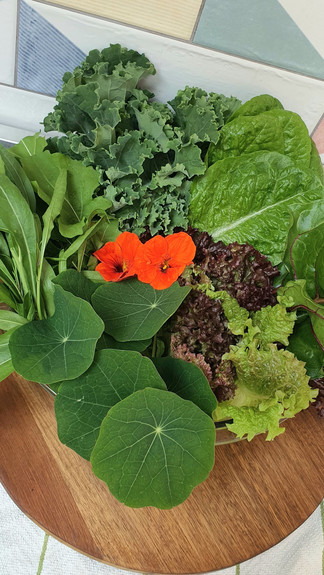6 Step Edible Organic Garden Planning
- Bridgette Macilwaine

- Apr 20, 2024
- 3 min read
Updated: Jun 5, 2024
It's wonderful to see the rising interest of people wishing to use their garden space for growing various edible plants, as well as areas for socializing and relaxing. Ensuring you get off on the right foot, the best starting place is creating a detailed plan with clear goals for the year ahead to understand what would be possible for your garden and allow you to move forward with purpose and confidence!
This hand drawn plan shows a draft layout for planning out growing locations for vegetables, herbs, edible flowers, fruit bushes, wildlife friendly plants and a combination of structural feature plants, for year-round interest.
Home grown garden produce beats grocery produce, in flavour, nutrition, satisfaction and appreciation! As with most urban gardens, we hope these spaces can be used for a range of social activities, hobbies and plant growing, which has been a challenge for this small urban garden.

With every year that passes, the quantity of produce from a home edible garden can vary greatly depending on time set aside for prep time, maintenance, pest control and harvesting, all depending on free time from family duties, child care and full time work. Although many mistakes are made, and lessons learnt, varying fresh meals harvested from the garden are an option for many months of the year.
Aims for the year ahead:
increase the quantity of food harvested from the garden
reduce food wasted because of pests eating them first
be more organised by not wasting growing space and planning out a crop rotation schedule
improve soil with home compost and beneficial soil additives to promote maximum vegetable growth
starts off seeds early indoors, ready to be planted in warmer weather and allow for continuous harvest

The process started with a spreadsheet (a basic list shared here) listing the plants you would like to grow, from which you could narrow the list down and think realistically about the space available and time needed.
This helps focus your mind on how much space is required for each plant, when they should be planted and harvesting times. From here we were able to analyse the sun/shadow movements and draw out realistically where these plants might grow best.

There are numerous online planning calendars that can help you to make a start with creating your own personal growing calendar, below are a few suggestions to help you get started (click the images to view full size):
When 2 Plant's sowing calendar and companion planting
Garden organic planting calendar and tips
🌱 Handy tip:
Using the shadow calculator website can be very helpful to plan out your garden for the year.
Most vegetable plants thrive in good sunlight of at least 6 - 8 hours a day, but here in England that can be quite tricky, and depending on your garden orientation or neighbouring trees which might cast long shadows. The approach to for many people can be as simple as "just give it a go" even if we think it might not grow so well there, it's worth a fun experiment and best case scenario we are able to harvest food from the plants.

The next step was to analyse the space and the shadows, starting with summer solstice (21 June) and noting the shadows across the space at 9am, 12pm and 5pm, as shown in this sketch image, these shadows have been overlaid to a single plan to better understand the suns movements across the space.
A useful website which allows you to check the shadows of your area during different times of the year for planning ahead - is shadowcalculator.eu
From here you're able to locate your house and draw on the shape of your house, garage, sheds, etc, as well as adding on individual building heights. The site then allows you to toggle through dates of the year and times of the day, which is a quick and easy way to see how shadows can affect your space. (As example map image shown here from the shadow calculator website).

A main concern for many when heading to the supermarket and filling the trolley with varying fruits and vegetables, and not considering where these foods have originated from, their travel miles,and their freshness.
Fresh food challenges:
awareness of where our food comes from
harvesting dates for freshness and travel
soil health and nutrient levels
pesticides use
environmental impact
flavour of food
So, what is one thing we can do??
Grow food from home in our small urban garden spaces.
Thanks for reading, if this interested you make sure to share with others who are growing from home, and would love to know your experiences, tips and stories too 🌱















Comments